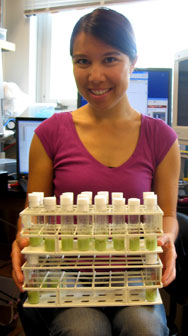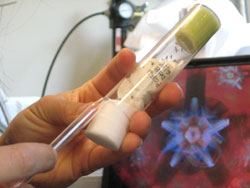 |
 |
|
 |
 |
 |
 |
 |
|
 |
 |
 |
 |
July 24, 2008
Fly Research Takes Off With High-Speed Video
By Joseph Caputo
 |
|
 |
Photos
Please click on thumbnails for full-sized images:

MBL Grass Fellow Gwyneth Card checks on her fruit flies, flown in from CalTech and housed in test tubes according to their date of birth. Credit: Joseph Caputo/MBL

Card extracts a fly by sucking it into a pipette through a plastic tube. Credit: Joseph Caputo/MBL

The horizontal line is one of several virtual stimuli Card is testing this summer to observe fly decision-making in response to threats. Credit: Joseph Caputo/MBL

The red light indicates the experiment is running. The fly grooms itself on the center prism as Card readies the virtual stimulus. Credit: Joseph Caputo/MBL
|
MBL, WOODS HOLE, MA—Gwyneth Card does a mean fruit-fly impression. Seated upright and arms tightly at her sides, she rubs her palms together to mimic how the insect readies itself to groom, apparently the most common of fly activities. Card would know. As a doctoral student in Michael Dickinson’s fly behavior laboratory at California Institute of Technology, she’s caught thousands of flies in the act. Although the study of insect grooming habits is tempting, Card is more interested in modeling the neurobiology of fly take-off. She is pursuing this lofty research question as a Grass Fellow this summer at the Marine Biological Laboratory (MBL) in Woods Hole.
| Video: |
|
| Stable take off: |
|
 |
 |
MP4
Quicktime
|
|
| Response to threat: |
|
 |
|
MP4
Quicktime
|
|
High speed footage of fly take-offs in response to a looming virtual disk. The more stable take off is a response to a virtual disk approaching the fly at 0.5 m/s and the tumbling take-off is a response to a virtual disk approaching at 1 m/s. Both videos were taken with a MotionPro X3-Plus high speed video camera provided by DEL Imaging. Credit: Gwyneth Card
|
|
Previous studies of take-off behavior were limited by the extent of human vision; a stopwatch and a pair of eyes are hardly accurate tools to measure how a fly prepares itself for the air. With the recent innovation of high-speed video, scientists like Card can now record fly behavior to the nearest millisecond, so fast that she can literally watch an action correspond to a firing neuron. According to Dickinson, high-speed video is making time as accessible to researchers as the electron microscope made visualizing the minutiae of cells and viruses, “When high-speed video is done well, you can see the circuitry through the animal’s skin,” he says.
At Caltech, Card recorded high-speed images of flies taking off voluntarily as well as in response to a looming stimulus, a falling plastic disk. As previous research suggested, the take-offs differed. When flies freely lift off, it is graceful. In quick succession, they raise their wings, extend their legs, shift their balance and fly away. When surprised, most flies trade stability for speed, jumping before they have time to fully expand their wings.
But not all flies jump away when the disk falls. The high-speed footage reveals that some of the insects merely prepare themselves to fly, moving their bodies away from the stimulus but not going through the full motion. Card and Dickinson hypothesize that the fly’s brain is wired like a thermostat. Only after a threat excites neurons past a pre-set threshold, measured in action potentials rather than temperature, does the insect decide to escape.
Card is using high-speed video at MBL this summer to learn what kinds of threats pass the danger threshold and which generate the pre-flight response. The footage is recorded directly into her computer so she can watch a fly’s behavior frame by frame as it responds to different computer-generated “threats.” A recipient of a 2008 Grass Fellowship, a grant that encourages young scientists to make new discoveries in neurobiology through creative design, Card wants her experiment to inform the first model of how a fly decides to initiate flight.
“It's actually a very challenging behavior,” Card says. “And what you want is a theory that's not just descriptive but may have some biological meaning. The best you can hope for is a general behavior algorithm, something relevant in all insects.”
Card’s protocol is simple enough to be automated; something she dreams will be possible in the near future. She collects a fly by sucking it up through a plastic tube and deposits it in a small black container. She turns to her apparatus, and places the container on a prism. In a moment, she will begin. The fly will be released and face a computer monitor that will display a virtual threat, its reaction recorded by the high-speed camera positioned above. To improve video quality, a mixture of red and infrared light shines on the insect.
For the fly, the world is a menagerie of shapes. Place a tree and dragonfly in front of one and it will see two rectangles, one horizontal and one vertical. Card’s “threats” take advantage of the visual capabilities of the insect. The first resembles the falling black disk. The image begins as a small dot in the center of the computer screen and expands to the edges of the monitor five second later. As she demonstrates, her fly, now grooming itself on the prism, readies its legs, but it must not reach threshold because it doesn’t jump. She has other threats she’d like to test this summer, including circles of varying contrasts and a funhouse swirl, but time is always a constraint.
“This needs to be a process,” Card says. “If you undertake behavioral studies you’re forced to be creative. My challenge this summer is to come up really well-chosen stimuli to show the fly.”
By the end of the season, Card will have seen enough hours of high-speed footage to clearly model for how the insect makes decisions in response to differently shaped threats. Whether or not the experience will allow Card to perfect her fly impression is still uncertain.
|
| |

 |
|
 |
 |
|